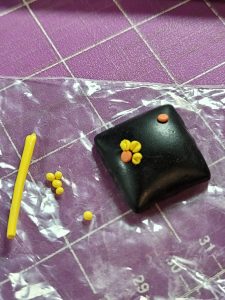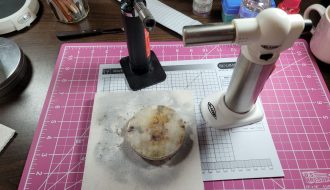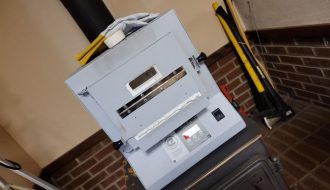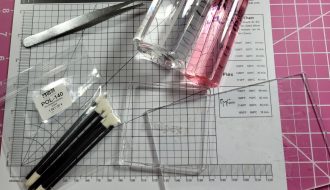Welcome back to my new series on Jewelry Clays.
Last time, we went into a deep dive on Polymer Clay types and brands.
Today, we are going to explore the Metal Clays in much the same way.

Metal clay is a crafting medium consisting of very small particles of metal such as silver, gold, bronze, or copper mixed with an organic binder and water for use in making jewelry, beads and small sculptures. Originating in Japan in 1990, metal clay can be shaped just like any soft clay, by hand or using molds. After drying, the clay is fired in a variety of ways such as in a kiln, with a handheld gas torch, or on a gas stove, depending on the type of clay and the metal in it. The binder burns away, leaving the pure sintered metal. Shrinkage of between 8% and 30% occurs (depending on the product/brand used). Alloys such as bronze, copper, sterling silver, and steel also are available.
Sintering is the process of fusing particles together into one solid mass by using a combination of pressure and heat without melting the materials. Common particles that are sintered together include metal, ceramic, plastic, and other various materials.
In the case of metal clays, it is heat that sinters the metal particles together into the solid mass.
Clay has several stages of drying–semi-moist, leather hard and bone dry. Semi-moist clay is still wet and malleable but quickly begins to dry along the edges. Leather hard clay is still too moist to fire, and you can make an indentation in it with your fingernail or dental tool. Bone dry clay is completely dry and can be sanded and fired. Semi-moist and leather hard clays are the easiest stages of dryness to make repairs or add additional clay to your design.

Most metal clays come in three basic forms:
Lump
Syringe
Paste
Metal clay may also come in powder and paper forms.
There are several types of Metal clay available on the Market.
Precious Metal Clays are offered in Fine Silver, Sterling Silver and Gold.
Base Metal Clays include varieties Bronze, Copper and Steel.
Differences of Note
As I stated in the Polymer Clay intro, many of the tools and set-ups for both of these jewelry clays are very similar. But there are a few very distinct differences.

While polymer clay can be cured in any oven under low heat, Metal clay has to be fired at much higher temperatures.
These temperatures need to be maintained accurately for a specified amount of time for the clay to become sintered.

In most cases, small projects of fine silver, copper and bronze clay can be torch fired without issues.
However, larger pieces and sterling silver clay projects are best fired in a kiln.

Also of note, is that base metal clays, including steel and larger pieces of sterling must be fired in activated carbon, inside a container. This is due to the level of oxidization that occurs when applying heat to these metals.

Another major difference between polymer and metal clays is the use of lubricants and water.
Metal clays are quite finicky to work with as opposed to polymers.
They can be quite tacky and require a release agent/lubricant in order to prevent the clay from sticking from everything from your fingers to molds and texture plates.
Metal clay is water based and can dry out relatively quickly. So you will want to keep distilled water on hand to keep your clay moist and workable.
Polymer clay can be reconditioned simply to working it through the pasta machine. But metal clays have to be rehydrated and stored in a damp environment.

PMC enables you create handmade silver accessories. This is an eco-friendly product, containing recycled silver.
As a solid-phase sintered product of a precious metal powder used to form a precious metal article, the material consists of microscopic particles of pure silver or fine gold and a water-soluble, non-toxic, organic binder that burns off during firing. Success was first achieved with gold and later duplicated with silver. The PMC brand includes the following products:
- PMC Standard: fired at 900 °C (1,650 °F) for 2 hours, shrinks by 30% during firing.
- PMC Plus & PMC Flex: fired at 900 °C (1,650 °F) for 10 minutes or 800 °C (1,470 °F) for 30 minutes; shrinks 15%, due to a particle size reduction. PMC+ is also available in sheet form which can be worked like paper; for example, for origami.
- PMC3: fired at 599 °C (1,110 °F) for 45 minutes or 699 °C (1,290 °F) for 10 minutes; shrinks by 10%. It can also be fired using a butane torch by heating it to orange heat for at least 2 minutes. It has a longer working life than the older formulations. It is also available in slip and paste forms which can be painted onto the surface of an object to be used as a mold.
- Aura 22: a 22-carat gilding material, a gold paste intended to be painted onto the surface of silver PMC pieces, or ready-made silver objects.
- PMC Pro: a harder product which is only 0.900 fineness silver, hence it cannot be hallmarked as sterling silver. It also requires kiln firing in a tub of activated carbon for 1 hour at 760 °C (1,400 °F).
- PMC Sterling: is fired at 815 °C (1,499 °F) and shrinks by 10–20%. Because of the copper content in this formula, firing is a two-step process; step one is an open-shelf firing and step two requires a firing pan with activated carbon media.
Art Clay Silver (ACS) was developed by AIDA Chemical Industries, also a Japanese company. ACS followed PMC Standard with their Art Clay Original clay (more like PMC+ than PMC Standard), which allows the user to fire with a handheld torch or on a gas hob. Owing to subtle differences in the binder and suggested firing times, this clay shrinks less than the PMC versions, approximately 8–10%.
Art Clay Silver New Formula
Aida has picked the best parts from their three most popular clays – easy molding from the Original, slow drying from the Slow Dry, and a low firing temperature from the 650 range. We think this might just be the ideal clay!
- It has a better workability and a longer working time than all previous Art Clay Silver products.
- It retains and accepts moisture easier than the existing silver clay types, which means it is easier to keep supple and much easier to reconstitute if it dries.
- It has similar drying times (when applying heat).
- It carves and files easier in the dry stage than the existing formulas.
- Fire with kiln, torch, or gas stove. Using a kiln the recommended time and temperatures are 30 minutes at 650°C on a continuum to only 5 minutes at 800°C.
- Shrinkage 8-9%.
- The clay can be hallmarked as fine silver.
Art Clay Silver Paste
This thick cream-like paste version of the silver clay is made for repairs, like filling in cracks and ‘glueing’ broken pieces back together.
You also use it to stick unfired pieces together, so you can build up large dimensional shapes by making, drying, and finishing each piece individually – when they’re all finished, you use the paste to stick them all together, which creates one solid piece after firing. It is a bit like a ceramic slip.
The paste can also be used to cover leaves, paper, cereals, and similar to make a fine silver replica.
If the paste is too thick, use a little water to thin it – only add a drop at a time, and stir slowly.
Art Clay Silver Syringe
This softer version of the clay comes in a syringe to make fine lines, dots and other decorations. Its thicker than paste, and it also has a slightly different binder, which ensures it will hold its shape when extruded.
There are different sized tips (nozzles) to choose from, range from very thin so you can do very delicate drawings, medium sized which makes perfect little donuts which you can set stones in, up to thick which is perfect for building up thick lines – ideal if you want to make a piece from only syringe.
It can be applied to a core shape which burns off during firing, creating a filigree or lace-like hollow form. It is great for surrounding and setting stones in the clay, and it is ideal for repairs as you can be very precise with where you add the syringe line, using a fine tip. Shrinkage 8-9%.
Art Clay Silver – Overlay Paste
This is Art Clay Silver in a water based paste form, which has been especially designed to use on glazed porcelain, ceramic and glass. After firing (temperature ranging from 650°C to 800°C), it will bond to the surface and won’t come off. Can also be used instead of normal Art Clay Silver Paste.
Art Clay Silver – Oil Paste
This oil based paste attaches to metal, so is used for repairing and fixing already fired pieces together, or for adding sterling or fine silver components to your silver clay pieces. It gives you a stronger bond than if you used the normal Paste. It comes with a thinning liquid to use if the paste dries up.
Art Clay Silver – Paper
The paper has a different consistency to the clays, it is completely dry and slightly rubbery. It is thin and flexible, and can be plaited, origami folded, punched, cut, or layered to create thicker sheets. Cut out shapes with a craft paper punch and decorate your clay pieces. Applique pieces (where you put Art Clay paper on top of Art Clay clay) should ideally dry in room temperature or a low temperature dryer to avoid cracking. The paper on its own does not need to dry before firing, it can go straight in the kiln. Don’t add any water to the paper. If you get any cracks, repair these after firing with the Oil Paste (adding water or normal paste will make the paper difficult to work with, and too much water will make it disintegrate). To apply paper shapes to a base clay piece, apply a small amount of thinned Art Clay Paste to the clay piece and apply the shape. Shrinks about 9-10% (as the shrinkage is higher than the clay, you can get some interesting doming effects if you add a lot of paper to clay).
Art Clay Gold 22 carat
This is the gold version of the clay, which can be worked just like the silver clay. Fires for 1 hour at 990°C. Shrinks 15%.
Art Clay Gold Paste and Accent Gold for Silver
These fantastic products are a economical and easy alternative to using the gold clay. It is simply pure gold in a liquid form, which you paint onto your fired piece, let dry, fire again, and burnish – and you have 22 or 24 carat gold accents! Super easy, and beautiful!
Art Clay Copper
A nice smooth clay to work with, with a gorgeous copper colour once fired. It is very easy to work with, but it comes out of the packet quite hard, and wants a little massage (wrapped up in cling film) before you use it to soften it a little. It does oxidise once open, so try to use the clay as soon as possible after opening. Vacuum wrapping is recommended. The nice thing with this clay is that it can be fired with a torch, so you don’t need access to a kiln. Once fired you’re left with 100% copper. Use separate (or very carefully cleaned!) tools as the copper can contaminate your silver clay. Shrinks about 10%.
Art Clay Silver 950
This clay features the same feel as the traditional fine silver clay but with professional strength. In fact, after firing, it is up to 60% stronger then fine silver clay. This combined with the added benefit of 1 step no carbon firing makes it choice clay for heavy wear items like ring, bracelets, clasps and much more.
These powder form clays come in a variety of single fire formulas.
- One Fire Clays
- One Fire Flex Clays
- Quick Fire Clays
They also have a cold inlay powder form. Hadar’s Clay™ Cold Inlay Powders are metal powders that can be inlaid into fired metal clay pieces using a cold process, without re-firing. Cold inlays come in silver, black, gold, and copper colors. They work for both inlay and repair.
Metal Powders USA also produce a line of metal powders that can be used for cold casting and inlays.
Now that we have a base knowledge of the different types of jewelry clays in grasp, we can move on into the nuts and bolts of working with jewelry clays.

Make sure to follow my blog for much more to come in the Jewelry Clay series.
Thank you for your support.
*The links in this article are my Affiliate links to Amazon. I make a small commission if you use these links to purchase your jewelry supplies. You can help support the free content on this site by using my links.

